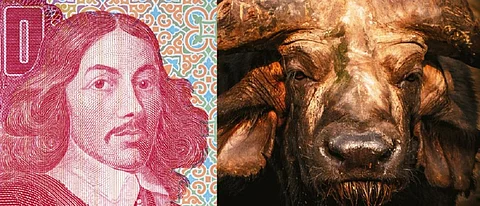

The Cape Buffalo, one of the icons of Africa, suffered decimation in what is today’s South Africa after Europeans began to colonise the region in 1652 Common Era (CE), a recent study has found.
The study, published in the journal Molecular Ecology last month, found that Cape Buffalo populations were less genetically variable or diverse in the extreme southern part of their range. This means that there had been more interbreeding among them.
The team of researchers considered and eliminated a number of hypotheses before finally coming to the conclusion that the lack of genetic diversity among the southern populations was linked to the mass hunting of the animals during the almost three centuries of European colonialism in the region.
The Cape Buffalo is one of the ‘Big Five’ species in Africa, the others being the lion, the leopard, the elephant and the rhino. These animals have long been considered the most dangerous by big game hunters in Africa.
The Cape Buffalo is especially feared as it is temperamental and unpredictable. It is one of the four subspecies of African Buffalo found south of the Sahara, the others being the forest buffalo, the West African Savanna Buffalo and the Central African Savanna Buffalo. The Cape Buffalo is found across the savannas of east and southern Africa.
Today, the African buffalo is categorised as ‘Near-Threatened’ on the International Union for Conservation of Nature’s Red List due to a number of factors including hunting, habitat fragmentation and culling.
However, studies in the past have shown that Cape Buffalo populations exhibited high levels of genetic diversity. The authors embarked on their study to find out what was the reason behind this.
They analysed and presented genome sequencing data of 59 individuals from across the Cape Buffalo range “to assess present-day levels of genome-wide genetic diversity and what factors have influenced these levels”.
“We found that the Cape buffalo has high average heterozygosity overall (0.40 per cent), with the two southernmost populations having significantly lower heterozygosity levels (0.33 per cent and 0.29 per cent) on par with that of the domesticated water buffalo (0.29 per cent),” the authors wrote.
They then considered hypotheses as to why this was so. They finally narrowed these to two:
Africa south of the Zambezi river was struck by a rinderpest epidemic in the 1890s that killed more than 5.2 million cattle, oxen, sheep and goats. It also killed wild populations of Cape Buffalo, giraffe and wildebeest.
“To our knowledge there is no indication that Cape buffalo in the southernmost part of the range suffered higher mortalities due to rinderpest than elsewhere on the continent. Therefore, we would expect similar levels of heterozygosity across the range if the loss of heterozygosity was mainly due to the rinderpest pandemic,” the scientists wrote.
They also found that the reduction in the populations of Cape Buffalo in South Africa started much before the rinderpest epidemic and continued afterwards.
The researchers thus inferred that the low genetic diversity in Cape Buffalo in South Africa would only have been caused by the start of European colonialism in the region.
Jan Van Riebeeck founded a colonial Dutch settlement on the Cape of Good Hope in 1652 that could serve as a way station for ships belonging to the Dutch East India Company travelling from the Netherlands to Asia.
The settlement grew into what is now Cape Town. It later expanded and became the Cape Colony. In 1795, the British defeated the Dutch and took over the Cape Colony. In 1910, the Union of South Africa was formed.
In 1948, the National Party under DF Malan started a policy of apartheid in the country which ended in 1994 after Nelson Mandela became the first black president of a multicultural South Africa.
The researchers found that the three centuries of white rule in the country (1652-1992) had far reaching effects on its Cape Buffalo populations, which have been mentioned in historical records.
“…There is a rich historical literature asserting that many large ungulate species declined rapidly following the establishment of the European Cape colony in present-day South Africa in 1652. These declines were caused by a combination of excessive hunting, fragmentation and reduction of habitat, as well as systematic eradication of wildlife, which was in some cases considered a nuisance for livestock keeping,” the authors wrote.
Several large mammals such as the bluebuck (Hippotragus leucophaeus) and the quagga (Equus quagga quagga) became extinct whereas the bontebok (Damaliscus pygargus pygargus), black wildebeest (Connochaetes gnou) and black rhinoceros (Diceros bicornis) became near-extinct due to white rule in southern Africa.
“In contrast, European colonization did not produce a similarly high impact on local wildlife until much later elsewhere in Africa with the establishment of the East African Protectorate in modern Kenya in 1895, the formation of German East Africa which covered modern-day Tanzania in 1890,” the authors added.
Colonialism in South Africa leaves a lasting legacy of reduced genetic diversity in Cape buffalo was published January 18, 2023.